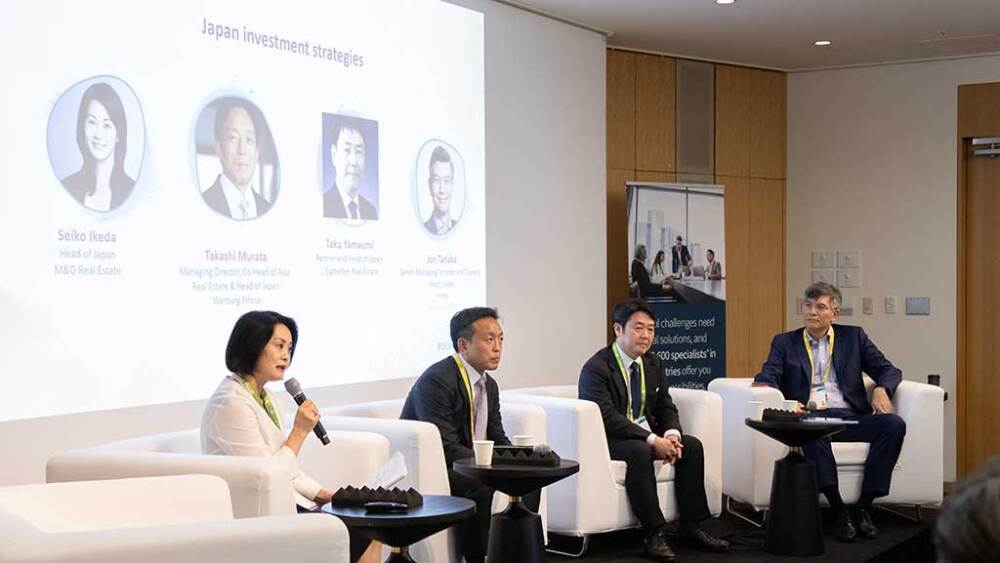Since global central banks began hiking interest rates in 2022, Japan’s lower cost of capital has made it a magnet for global investors seeking deals in one of the very few major markets still offering positive yield spreads.
While that has ensured robust flows of incoming capital, market fundamentals are not completely supportive. For one, ongoing currency depreciation threatens to undermine returns in U.S. dollars. In addition, the Bank of Japan continues to telegraph imminent increases in policy rates, which has led to widespread concern—and focus—on the compressed cap rates of real assets.
A panel of Japan-based investors and asset managers attending our 2024 Asia Pacific Summit examined the dynamics of these crosscurrents on local markets.
According to Taku Yamaumi, partner and head of Japan for L Catterton Real Estate, concerns over interest rate movements may be overblown. “Last year, long-term borrowing costs already increased moderately,” he said, “but cap rates still compressed or stayed flat, which shows interest rates are not the only driving factor.”
While interest rates may be set to rise moderately, Yamaumi continued, “we think cap rates are more a function of rental growth, and with [current] wage growth at 5.3 percent—the highest in 30 years—it’s not unreasonable to expect wages, together with strong consumer and business sentiment, will lead to higher rental growth for multifamily and retail assets. If growth is strong enough to match the rising cost of capital, we think capital values should hold up well.”
Another factor that may help sustain compressed cap rates is the vast amount of domestic institutional capital that is willing to invest at sub-three percent yields. According to Takashi Murata, managing director and co-head of Asia real estate at Warburg Pincus: “Cap rates aren’t just a function of yield spread. They reflect many things, such as money supply, economic outlook, and market rent rolls. But I’ve seen very strong domestic bias [among local institutions] that I think will last a few more years.” Beyond that, he said, “it’s very difficult, given where rates are, for yen-denominated capital to leave [Japan], especially if you don’t have a great platform of people—and that further entrenches Japanese capital in Japan.”

Seiko Ikeda, head of Japan for M&G Real Estate; Takashi Murata, managing director and co-head of Asia real estate at Warburg Pincus; Taku Yamaumi, partner and head of Japan for L Catterton Real Estate; and moderator Jon Tanaka, senior managing director, Hines, speaking at the ULI Asia Pacific Summit.
(ULI)
Still, times are changing, and investors in Japan—as in other markets—are increasingly moving away from traditional core assets in favor of “new economy” themes. “I see how people’s lives are changing, and how business operations are changing, with more digitization,” said Murata. “So I think you need to go beyond just the real estate itself sometimes, to try to capture the opportunity.”
In terms of specific asset classes, multifamily projects continue to draw capital, given what investors see as solid fundamentals. According to Seiko Ikeda, head of Japan for M&G Real Estate: “Occupancy is quite resilient, even during downturns. Tenants aren’t buying and are now staying longer in rental apartments because [capital] prices rose sharply. In addition, there is strong coordination between rental growth and inflation. As wages started to grow last year, rents for new lets increased, especially in prime areas and especially for larger units.”
Hotels have been enduringly popular in the last couple of years, especially among foreign investors, but the hospitality ship may have sailed. As Murata observed: “It’s becoming harder and harder to find deals, so you probably have to have a platform you can hang your hat on and take a different view from your competitors, or just be more creative in terms of sourcing, or structuring, or in terms of deals. But I also think: why would current owners sell to you? It’s a great sector from a real estate perspective, but not realistic in my opinion, unless you buy land and build. But then I’d rather not be a primary builder of hotels, especially luxury hotels; I’d rather buy it from someone who already built it and failed. And there are not many of those people left.”





